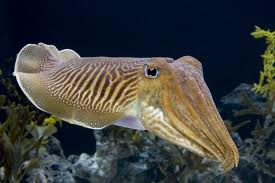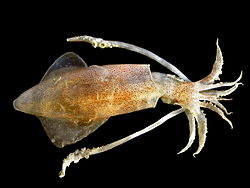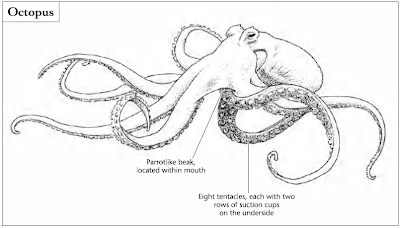The most intelligent and highly developed mollusks are the cephalopods. The name cephalopod literally means “headfoot” and refers to the fact that these animals have their feet, in the form of tentacles, in the head region. Members of this group that live around coral reefs include squid, octopuses, and cuttlefish.
Unlike bivalves and gastropods, most cephalopods have no shells, although squid and cuttlefish both have small, flexible pieces of shell material inside their bodies. In squid this material is called a pen, and in cuttlefish, a cuttlebone. A cuttlebone has chambers that can trap gases and give the cephalopod some buoyancy, while a pen is solid.
For protection cephalopods depend on their well-developed nervous systems and sense organs. Their eyes are extremely advanced and similar to human eyes. The primary difference is that the cephalopod focuses its eye by moving the lens back and forth, like a camera lens. In humans, the lens is focused by changing its shape.
A cephalopod body is designed for a free-living, predatory lifestyle. Octopuses are found singly, crawling across the bottom of the reef on their eight tentacles (see Figure below). They spend a lot of time hiding in reef crevices and among rocks. Squid swim around in small schools, traveling head first with their 10 tentacles trailing behind them. Cuttlefish, which also have 10 tentacles, are most often found near the bottom of the reef. In all types of cephalopods, the tentacles encircle the head. These extensions are equipped with powerful suction cups for grasping prey. In the middle of the circle of tentacles is a mouth with strong, beaklike jaws.
 |
| Cuttlefish, which also have 10 tentacles |
 |
| Squid also have 10 tentacles |
 |
| An octopus has eight tentacles |
 |
| An octopus has eight tentacles, each with two rows of suction cups. In the center of its body is a hard, parrotlike beak. |
In cephalopods, sexes are separate. The male has a specialized tentacle that transfers packets of sperm from his mantle cavity to the female’s mantle cavity. After her eggs are fertilized, she lays chains of egg capsules on the reef floor or in caves. The female octopus broods over her eggs, blowing oxygenated water across them. During this time she eats little and dies after about 10 days. The eggs develop directly into juveniles, skipping the larval stage.
The blue-ringed octopus (Hapalochaena lunulata) is a lethal reef hunter. Its venom is located in saliva, so after biting its victim, the octopus spits venom into the wound. From above, the blue-ringed octopus is inconspicuously colored. However, when threatened, it flashes its bright blue warning rings.
The Atlantic oval, or reef, squid (Sepioteuthis sepioidea) is 10 inches (25 cm) long with oval fins that begin near the mouth. Its yellowish skin is covered with purple dots. This squid swims with its short tentacles bunched, making them look like they are part of the head.
One species of cuttlefish found around the reef in the summer is the flashback cuttle (Sepia latimanus). This cephalopod comes into shallow, warm water to mate among the corals. In the daytime, the cephalopod stays near the bottom but becomes active at night. Its skirtlike fin encircles the body and helps stabilize the animal while swimming and hovering.
